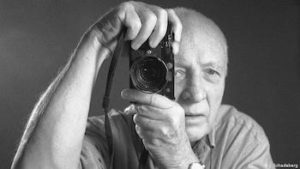
Jürgen Schadeberg
*Jürgen Schadeberg was born on this date in 1931. He was a white German-born South African photographer and artist.
Jürgen Schadeberg was born in Berlin, Germany, in 1931, where he grew up during the Nazi regime and World War II. In the aftermath of the war, his mother began a relationship with a British officer in the Army of Occupation and emigrated with him to South Africa in 1947. Schadeberg learned to be a photographer at the Deutsche Presse-Agentur (German Press Agency).
In 1950, he moved to South Africa to rejoin his family and, the following year, found employment at Drum magazine as an official photographer and layout artist. Schadeberg became the senior figure of the staff and a teacher and mentor to some of the most creative South African photographers of his time, including Bob Gosani, Ernest Cole, and later Peter Magubane. As one of the few white photographers who photographed daily life in the black community, he became knowledgeable about black life and culture.
As a result, he captured on film the beginnings of the freedom movement, the effects of apartheid, and the vibrancy of township life. Schadeberg photographed many historic and pivotal events in the 1950s, including the Defiance Campaign of 1952, the 1956 Treason Trial, the Sophiatown removals of 1955, the Sophiatown jazz and social scene, the Sharpeville funeral of 1960, and pictures of Robben Island inmates. Some famous people he photographed include Nelson Mandela, Walter Sisulu, Oliver Tambo, Trevor Huddleston, and Govan Mbeki. He also documented 1950s jazz legends such as Thandi Klaasen, Hugh Masekela, Kippie Moeketsi, and Miriam Makeba. He made documentation of everyday life.
When Drum wanted the singer Dolly Rathebe to be the cover girl for one of their issues, Schadeberg took her to a Johannesburg mine dump and photographed her in a bikini. The two were arrested for contravening the Immorality Act, forbidding interracial relationships. In 1959, he left DRIM magazine. Increasing racial unrest forced him to leave South Africa, and in 1964, he went to London to become the picture editor of Camera Owner magazine. He also taught and curated photographic exhibitions in England, notably for the Whitechapel Art Gallery. He then moved to Spain, where he focused on a career as an artist.
In 1972, he returned to the continent as a photographer for Christian Aid in Botswana and Tanzania. 1973, he took photographs in Senegal, Mali, Kenya, and Zaire. Schadeberg was part of an expedition from the University of the Witwatersrand to study the Bushmen, publishing images in The Kalahari Bushmen Dance in 1982. In 1985, Schadeberg and his wife Claudia lived there while he continued to work as a photojournalist and made documentaries about the Black community until 2007 when he returned to Europe.
He photographed key moments in South African history. His work is held in the collections of the UK Arts Council, the National Portrait Gallery, Tate, and the Victoria and Albert Museum in London. Jürgen Schadeberg died from a stroke at his home in Spain on August 29, 2020, at the age of 89.